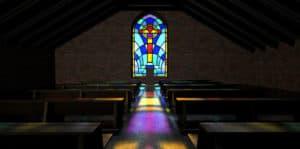
I was raised by Christian parents who were active in our small-town United Methodist Church. One Sunday when I was around four years old, I was with my mother who was in charge of the nursery during the worship service that day. I remember picking up a large, thick book and thumbing through the pages looking for the few pictures scattered throughout. I was fascinated with the vast number of pages…and so many words. I took the book to my mother and showed her, exclaiming, “Mom, look at all the words in this book!” She remarked back to me, “That book is the Bible, Al, it’s God’s Word.” A few years later, when I was about eight years old, I stood near my mom as she made the bed and nervously declared, “I think I want to be a minister when I grow up.” In those days the term minister referred to the reverend, pastor or preacher in charge of a church. I wasn’t interested in being the head of a church though. What I really wanted was to have a thorough understanding of the Word of God and to teach or preach. At the time I was under the assumption that in order to obtain the type of understanding I was interested in one had to go to school and seminary to become a pastor. Looking back I realize what I really desired was to become somewhat of a theologian.
I graduated from Girard High School (Pennsylvania) in 1972. About that time, my sister gave me my first book on Bible prophecy. It was the classic, The Late Great Planet Earth, by Hal Lindsey. Shortly afterward, I left the Methodist Church as it had become too liberal in its teaching and doctrinal stance for my taste. My sister introduced me to the Girard Christian and Missionary Alliance Church she had been attending. It had a full gospel message and a strong adherence to a literal, wholistic interpretation of the Word of God. Though there were a few diverse views among the members regarding various Bible subjects, the Holy Spirit seemed to be moving in that church. In those days End-Time prophecy was a hot topic and the pastor would occasionally speak on the subject. Hal Lindsey’s book had piqued my interest and I wanted to get a better handle on prophetic issues, so I was in the market for good reading material and messages on the second coming of Christ, the rapture of the Church, the 7 years of Tribulation, Revelation, and all the related subjects.
I began my freshman year at Edinboro State College in the fall of 1972 and lived on campus in a dormitory. I chose Philosophy for my major based on the recommendation of a Methodist pastor I admired before my defection from the church. I returned from Christmas break in January of 1973, ready to start my second-semester classes. The first day back at the dormitory always involved catching up on what happened to everyone during our break. One of the guys living down the hall from me had just bought a book on End Time prophecy from the college bookstore and told me a little about it. He reluctantly let me borrow it briefly but I soon knew I had to get a copy for myself. I practically ran to the bookstore and purchased, if memory serves me right, the very last copy. The book was titled, Guide to Survival and was written by a born-again Arab by the name of Salem Kirban. He was doing much of his own marketing in promoting his publications and outreach ministry. The book was easy to read and understand and had lots of charts and pictures. It was a great book to read to obtain a solid foundation of what the pre-tribulation rapture theological viewpoint was all about, as well as briefly introducing two other prominent viewpoints at that time, known as the mid-tribulational rapture and the post-tribulational rapture theological positions.
There was already a bit of a stir on our dorm floor about Guide to Survival, but before I fully read the book myself, I talked to another student living down the hall from me, about the pretribulation rapture of the church and the sequence of some of the major events associated with the second coming of Christ. “Does the Bible really teach Jesus is coming back, and that Christians will just vanish? Can you read about all that stuff somewhere in the Bible?” he asked. “Sure!” I responded enthusiastically. “Come to my room and I’ll show you from my Bible.” Once in my room, I immediately turned to Matthew 24 and the Olivet discourse, presented by Jesus to His disciples regarding His second coming. I read the verses out loud and occasionally inserted a bit of commentary to help explain things and highlight issues I had mentioned to my friend before we read the Word together. But it wasn’t very long before I got quite uncomfortable. The words of Jesus were not lining up with what I had already explained and outlined earlier to my friend regarding the sequence of events such as the rapture of the church and other important points. I stammered on a little further and then in utter embarrassment openly admitted that the text I had chosen didn’t match what I had verbally presented earlier in our conversation. I confessed I was ignorant about a lot of the issues and was just beginning to learn myself. He said he understood my predicament, suggesting the Bible is confusing at times and hard to understand. While I don’t remember his name, I remember the dejected look on his face as he stood up and walked out the door. I also remember the stinging, burning sensation of my blushed cheeks. I had blown it—period. Right then and there I made a commitment to myself it would never happen again.
I wish I could tell you…”With great resolve and determination, I dove into God’s Word to objectively determine how all the prophetic puzzle pieces fit together without forcing any to fit in some spot I wanted them to, for the purpose of supporting some theological bias.” The truth is, I did not turn to the Bible for accurate instruction and understanding. Instead I sought out scholars, theologians, authors of books, radio Bible teachers and preachers. These “experts” on the Bible would set me straight…or so I thought.
I quickly learned the “mistake” I had made with my friend, was going to the Olivet discourse for discussing End Time events from the perspective of the Church. You see, the Olivet discourse was given to the twelve disciples before Pentecost. They were still part of the dispensation of the Jews at that time, therefore the Olivet discourse pertains to the Jews, not the Church. That is…according to many authors of books and preachers of sermons. (For those unfamiliar with the term “dispensations” a very brief explanation would be to understand it as divisions of human history made by theologians in an effort to categorize differing relationships between God and people during the course of human history. Opinions differ among scholars as to the best way to determine these divisions and interpret their meaning.) My solution was to develop a handy-dandy timeline chart as a teaching aid. When discussing prophetic issues I would deftly set aside the Bible, then grab a pen, take a piece of paper and draw a big line across it representing the Seven Years of Tribulation. I would then confidently insert strategic divisions illustrating where and when key events, features, and issues came into play. I would support my artistic work by citing isolated scripture verses and references during my explanation of the various points I would make. Using the chart with isolated Scripture verses made for a nice, clean, logical, understandable, and impressive presentation…without any glitches.
When I had a little money, I would go to the Christian bookstore and look around to see what books looked good enough to buy. I would always take a look at the page providing a bit of the background about the author. To me, it was always an important issue. If I wasn’t impressed by the author’s background or profile, chances were great I would put the book back on the shelf and go on to the next one. Since Hal Lindsey went to Dallas Theological Seminary, uppermost on my list were authors having an association with Dallas Seminary. For me it was simple. I wanted to learn from the best, and, “the men from Dallas” as I like to refer to them, had an excellent reputation in the conservative, evangelical circle of Christians that I associated with. I even fancied myself someday applying to Dallas Seminary to get a Master’s degree after graduating from college.
It is important to know that while all of this is going on, fresh out of high school I had started dating the girl of my dreams. (In 2017 I wrote an eleven-page paper for an English composition class about how I got this girl to marry me.) We married in 1974. Much to the encouragement and delight of my then current pastor, we soon moved to Nyack, New York. I intended to transfer from Edinboro College to Nyack Missionary College, which was largely supported by the Christian and Missionary Alliance. The plan was I would go to school and work part time while my wife would work full time to help put me through college. The cost of living was extremely high in that area. When we discovered she was pregnant with our first child we knew we would have to move as we could not afford to live there, even if I worked full time and did not go to school. We moved back to Edinboro where it was more affordable to live and I could work fulltime to provide for my family while continuing my schooling part-time. We moved into a townhouse apartment in a complex off campus. A few units down from us lived a pastor and his family. During our first introduction, he asked several questions about my background and plans during and after college. While I was providing answers to his questions, I expressed an interest in attending Dallas Seminary after graduating from Edinboro. When Pastor Mike revealed he was a graduate of Dallas I was totally awestruck! We became immediate friends and more importantly, he would become my mentor.
I started attending his church services and Bible study classes. I visited his home often, and he would show me what he was studying. He began to groom me in the realm of doctrines of the faith, particularly according to the teachings of Dallas Theological Seminary. I was an eager student. This was what I unknowingly longed for since that time I confessed to my mom I wanted to be a minister when I got older. Pastor Mike’s teaching and instruction contained what I craved most—depth and detail. He was among an informal group of pastors, mostly graduates of Dallas, known as ICE teachers, noted for a particular teaching style. ICE is an acronym for the isagogic, categorical, and exegetical method of teaching the Word of God. For me, it was better than going to Dallas Seminary as I did not have the pressure of academic rigors, yet was still able to get an advanced education. I felt very privileged to be under the teaching ministry of Pastor Mike. After three or so years however, I couldn’t shake my desire to teach. The problem was there weren’t any opportunities at Mike’s church, as the congregation was surprisingly small. It always perplexed me that, here was a graduate from Dallas, yet not many people came to check out the church or the pastor. But Pastor Mike never seemed concerned about the small number of members or visitors.
Eventually, I quietly slipped away from attending Mike’s church and went back to Girard Alliance Church. I compiled material to teach an adult Sunday School class and was granted permission to compete with other teachers who were also offering classes on various subjects during an open enrollment period. I was delighted when a few brave souls signed-up for my class. I was up against some distinguished, well-established, and very capable teachers within the church. While I was well-known I wasn’t in the “clique”, and I knew my style would not appeal to everyone. Still, I felt there might be some who would appreciate a class that offered depth and detail, just as I would have. The Sunday School program was on a quarterly system, which worked out great for me. I would teach a couple quarters, then take time off to develop new material and jump back into teaching again.
In the fall of 1998 I was preparing material to offer a class on Dispensational Theology. I was rather excited about it, thinking this would be a subject many in the church would find interesting and gain benefit from. I had just started to dive into the project when a good friend and co-worker at the manufacturing plant I worked at approached me about a dilemma he was having. Jim Adamson was several years younger than I was, and also a fairly young Christian. We had good times discussing various biblical subjects, and Jim was always eager to hear my thoughts on a matter. “Al, I’m still developing my personal theology on the Second Coming. You shared with me your position on the timing of the rapture being pre-trib and all that, but I’m not convinced that’s what the scriptures teach, especially after reading this book. I was wondering if you would do me the favor of reading it, and explaining to me why you think this author’s position is wrong…from the Bible?”
Kids…what do you do with them? I had already taken Jim under my wing. I had already taken a piece of paper and drew a nice timeline for him, seasoning every point with at least one verse from the Bible for documentation…and now he’s questioning me? But he was a friend; he was a brother in Christ. And, Jim was a “young buck” on fire for the Lord. No one ever said being a mentor would be easy. I just couldn’t turn him down. It was my turn to make sacrifices for the benefit of another.
He handed me the book in question and I looked at the back cover for an assessment. Jim attended a church with Charismatic theological tendencies. In the crowd I ran with, Charismatics were frequently profiled as followers of Covenant Theology, a position in opposition to the teaching of the Dispensationalists. This was a little ironic to me, since, as mentioned, I was going to offer a Sunday school class on Dispensations. No big deal, I thought to myself. This favor should only set me back a few days or so from developing the Sunday School material.
I apologize for not being able to remember the title of the book, but I do remember the author being a gentleman by the name of James McKeever. Within the first several pages of the book, James earned my respect for him as an author. He presented himself as a humble man; he never appeared haughty or belligerent. He beseeched his readers to have an open and honest spirit when evaluating his writings. His targeted readership were people like me, those professing the pre-tribulation Rapture theological position. His approach was just right to capture my attention and consent to take a fresh look at an old, rejected interpretation of the scriptures.
The Covenant theological position on the rapture of the Church and the second coming of Christ, stated very briefly and overly simplified, is that both occur after the completion of the so-called 7 Years of Tribulation, and is known as the post-tribulational rapture position. (I see no profit to the reader to expand on this. There are plenty of books to read for those desiring to look into it further.) For sure, James did not persuade me to forsake the pre-tribulation rapture view in favor of the post-tribulational view. He did, however, perform an absolutely amazing feat; he caused me to have a powerful doubt that the foundation of the pre-tribulational rapture position had rock-solid scriptural support. Until I had read his book it had been hard for me to understand why there was such a debate over when the rapture was to occur. In my eyes, all the theological giants (as in, the men from Dallas Seminary) were pre-trib’ers, and that was enough for me. (I later found out there were several men who attended DTS who do not ascribe to the pre-tribulational rapture theological position.) Obviously, if the most respected and highly trained theologians in the world believed the scriptures taught that position, it must be accurate. But by the time I finished reading McKeever’s book I was literally ill. I was depressed and my stomach was queasy for days.
I described my dilemma to Jim, telling him that while I still believed the post-tribulation position was not an accurate interpretation of the scriptures, I now had doubts about the validity of pivotal points of the pre-trib position. He seemed oblivious to my emotional distress and rather glibly informed me that over the weekend he found a book he purchased about four months prior…and forgot about. Somehow it got buried in a bunch of stuff in the back seat of his car and had not yet been read. “Maybe this guy has the right answer.” Jim said, handing me the book while sporting a broad smile on his face. “You should read this one and see. Tell me what you think.”
The truth is, I was in no mood to read another book at that point. I was still reeling from having my convictions regarding the pre-tribulation rapture theological position shaken. But after reading just the front and back covers of the book I couldn’t begin fast enough. The book’s title was The Pre-Wrath Rapture of the Church, by Marvin Rosenthal. He too, had long been a confirmed pre-tribulationalist. But he revised his theological position after a few years of debates and discussions with a close friend who challenged him repeatedly. Ultimately, it was Marvin’s commitment to the Word of God rather than the doctrines of men, that forced him to abandon the teachings of the pre-tribulation rapture position in favor of what the scriptures themselves plainly present to the student diligent enough to discover biblical truth. This change in theological position was quite costly for Mr. Rosenthal, on a personal and ministerial level. He discusses his anguish and sacrifice in his book.
As I read Mr. Rosenthal’s book the scriptures seemed to fall into place and made sense without the need to gloss over, manipulate, bend or remove them out of context. In a short time I too, became a proponent of the basic tenets of the pre-wrath rapture position. However, I yearned for a deeper study and understanding of all the involved scriptures. Mr. Rosenthal’s book mentioned the friend who doggedly pursued Marvin, throwing all sorts of questions that were more than just difficult to adequately defend from a pre-trib position, and which ultimately resulted in Marvin’s defection from the pre-tribulational rapture camp. The friend’s name was Robert D. Van Kampen. He also had written a book titled: The Sign. I immediately procured a copy for myself…and devoured it. For the reader who has not yet read my book, you may be wondering what this “pre-wrath rapture position” is all about. I don’t mean to disappoint anyone but I greatly prefer that you learn what it’s all about by reading my book, allowing each sequential chapter to unfold its unique lesson. Others who have already taken the journey through my book already know what it’s about so there is no need to repeat it here.
I thoroughly appreciated the depth and detail of The Sign. It was written in a style that was just right for the way I like to learn. After digesting and contemplating the contents and discussing various points with some friends (including my buddy Jim), I kept seeing how the Lord’s discourse on Mt. Olivet right before the crucifixion was such a center point, and truly a pivot point connecting the Old Testament prophecies with supplamental knowledge that would be provided later by the inspired writers of the New Testament. I wondered if I could find a decent commentary on the Olivet discourse given from a pre-wrath perspective. Astonishingly, right at that time, Mr. Van Kampen started offering a cassette tape series on that very subject. They were recorded during a lecture series given to a church group who had invited him as a guest speaker. It was with eager anticipation I ordered the set, anxious to hear how he would approach this pivotal section of scripture.
When the six cassettes arrived I eagerly listened to all the tapes in one day. Surprisingly, I was greatly disappointed! There was none of the detail and depth as expressed in his book. It was discouraging, as I wanted to organize material on the pre-wrath position and present it as a Sunday School class. I knew a thorough understanding of the Olivet discourse was essential for what I wanted to do. My vision was to key-in on the discourse, using it as the foundation of the class material. I understood the Olivet discourse to be the Lord’s outline, framework, the skeleton if you please, upon which the rest of the scriptures would “flesh-out”, augment, supplement and complement what the Lord established in the discourse given to the apostles. With no one to turn to, I turned to the Word of God. I was going to make my own commentary on the Olivet discourse. How ironic that the very chapters of the Bible which had given me fits…and subsequently discarded in 1973, would now be the foundation of my new Sunday School series, years later.
At that time in my life I happened to have extra time to devote to a detailed study. I armed myself with lots of tools. I took my Strong’s Exhaustive Concordance, Vine’s Expository Dictionary, Greek New Testament, American College Dictionary, King James, New American Standard and New International versions of the Bible, selected books and commentaries from various sources, pens, pencils, lots of paper…and a very deep breath. I plunged into the project with stout resolution, determined to plead for the leading of the Holy Spirit and accept the truth whenever I could discover it. I would do my best to place scriptural puzzle pieces where they naturally fell together. There would be a conscious effort to avoid shaving any edges to allow pressuring them to fit a place they resisted fitting into. If I felt like I was committing a violation of this rule, I would at least admit perhaps my opinion wasn’t necessarily accurate, allowing for other possible views to be considered. I wanted to be transparent and honest. Well, you know how it is with noble goals—sometimes it’s hard to always hit the mark. I cannot honestly say I always did.
After many hours of research, I had plenty of material ready to present and teach, even though I wasn’t totally done with the study. I took advantage of an opportunity to offer a class when it was time for people to sign up for the Sunday School class of their choice at the end of the quarterly cycle our church was operating under at the time. The process of offering a class had recently changed. I had to present a written summary about my course and present it to the “gate keepers”, those in charge of curriculum. While everyone else was teaching a class using a book or video from some prominent author on the scene back then in the 1990’s, I simply made a request to teach on the Olivet discourse, right out of the Bible. I unveiled a very bland, uninformative outline, without revealing anything about my pre-wrath position. My request met with mild resistance because there was no way to tell if it would be politically/theologically correct, so-to-speak. A prominent elder in the church defended my submittal, questioning the authorities why a request to teach from the Bible would draw suspicion? Since I had taught before and had gone through the Teacher Training and Certification program recently enacted at the church, I was permitted to place my class offering on the sign-up table with the others, while being told not to be discouraged if few people elected to attend the class. But people did sign-up for my class.
It is now time to bring this part of the story to a conclusion. (There is another, whole “chapter” to my story, but I am not going to include it here, in spite of some exciting drama that occurred.) Over a period of about two years I presented my material to different classes of adults. Not surprisingly, I encountered resistance from a Sunday School superintendent who became suspicious about my teaching, even though he hadn’t attended the class series. (He is a main character in my reference to another “chapter”.) Yet none of the regular attendees put up a fuss about the content I was teaching, or, more importantly, the scriptural validity of what was covered in class. I did, however, receive many encouraging comments and many appeals to turn the material into a book so people could read it. The classes I taught were attended by elders, deacons, ordained ministers, other Sunday School teachers, missionaries, well-educated laymen with bachelor degrees, masters, and even doctorates, along with ordinary people interested in biblical truth.
To these and many other people who had an impact on my teaching experiences I am indebted for the production of this book. To others, though never having me as a teacher in any of the classes I taught, I express my heartfelt thanks, good friends, for the encouragement you provided, your feedback and precious time extended to me and this work. I regret taking so long to get the book to this point. My excuse is a false sense of humility in wondering how God could use a guy like me…and this, my offering, to glorify His Son. I relate to Amos, who claimed he was no prophet, merely a herdsman and a grower of sycamore figs. I have none of the significant qualifications expected of an author creating a work of this magnitude, except a servant’s heart that wanders far too often from the sight of the Father’s will and plan. If any are blessed by this work, to God be the glory, and to His Son, Jesus Christ! I hope you enjoy your journey as you go through The Olivet Discourse Commentary!





